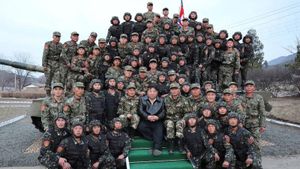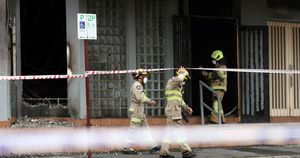President Donald Trump's attempt to tackle California's water management head-on has drawn sharp criticism, as his administration's recent orders led to the abrupt discharge of billions of gallons from two major reservoirs in the state. The moves, officially sanctioned by the U.S. Army Corps of Engineers, were framed as emergency measures to help fight wildfires.
The announcement came early Friday, following Trump's January 24 executive order demanding increased water flow from California's dams. This directive was interpreted as necessary for combating wildfires looming over Southern California. "Consistent with the direction in the Executive Order on Emergency Measures to Provide Water Resources in California, the U.S. Army Corps of Engineers is releasing water from Terminus Dam at Lake Kaweah and Schafer Dam at Success Lake to assist California during this crisis," explained Gene Pawlik, supervising public affairs specialist for the Corps.
Trump himself boasted about the water releases on social media, declaring, "Today, 1.6 billion gallons and, in three days, it will be 5.2 billion gallons. Everybody should be happy about this long-fought victory!" He lamented, "I only wish they listened to me six years ago – There would have been no fire!" He called the measure the culmination of his long battle against what he characterized as inefficient state water management.
Despite Trump's bravado, the reality on the ground painted a different picture. Local officials expressed deep concern over the rapid and unscheduled water releases. They cited both the physical and legal barriers complicATING the transport of this water to areas impacted by wildfires, leading to frustration as many described the situation as politically motivated. Kaweah River Watermaster Victor Hernandez offered perspective: "Every drop belongs to someone... If someone's playing political games with this water, it's wrong."
The abrupt announcement left water managers with barely one hour to prepare for the increased flow, necessitating immediate conversations with emergency responders and farmers about potential flooding repercussions. The release transformed river flows dramatically, with the Tule River's rates leaping from 55 cubic feet per second to nearly 1,000 cubic feet per second just after the decision. The Kaweah River surged from 5 cubic feet per second to over 1,500 cubic feet per second.
Political tensions intensified as Senator Alex Padilla publicly condemned the Army Corps for not coordinating the water release adequately with local officials. Padilla stated, "We traditionally have a high degree of coordination at the operational level, which wasn't part of this decision," casting doubt over the justification of the resource allocation.
Water management experts like Dan Vink voiced alarm, underscoring the severity of the situation and clearly expressing dissatisfaction with President Trump's approach. "This decision shows complete ignorance of how the system works and sets a dangerous precedent," Vink commented. He added, "An unscheduled release of water at this time of year... poses grave threats to water reliability this season."
For farmers reliant on the water flowing from these reservoirs, the actions of the Army Corps were seen as nothing short of reckless. "This takes water out of their summer irrigation portfolio," Vink said. The growing concerns over potentially wasted water resources were compounded by the simultaneously reported series of rain events forecasted to impact California soon, making the release feel even more unnecessary.
California's Governor Gavin Newsom took steps to mitigate potential water shortages by issuing an executive order aimed to maximize storage and capture storm runoff for later use. "It is more important than ever to recharge our groundwater supplies," Newsom highlighted as he worked to secure the state's water future amid the chaos stirred by Trump's directives.
Despite the federal action appearing chaotic, the California Department of Water Resources, led by Director Karla Nemeth, highlighted the desperate need for collaboration. "We must maximize every opportunity," said Nemeth. The lack of efficient coordination has amplified distrust between California officials and the federal government, particularly as the contradictions surrounding the necessity of the water releases loom large.
Senator Padilla's discontent was emphatic, as he demanded transparency and clarity about the decisions taken by the Army Corps. He urged the Department of Defense to clarify the rationale behind the water release strategy and how it corresponds with the state’s needs and the safety of its citizens.
Critics of the Trump administration’s handling of water resources warn such unilateral actions jeopardize years of efforts to create sustainable practices for managing California's water. The federal push to accelerate water distribution without local input might not only lead to immediate crisis but also set back efforts to transition toward long-term solutions.
With both sides of the water debate entrenched, farmers and local officials are left grappling with the repercussions of these political games. The dire warnings from water managers, the concerns expressed by political leaders, and the outcry from the local electorate combine to question whether the Trump administration's controversial approach to California water management can deliver the promised results without alarming side effects.



